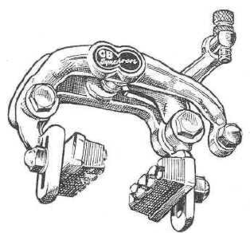I grew up admiring them and dismantling/cleaning/mucking up at times (all part of the learning process as a kid - didn't have computers in the good old days  ).
).
I still think they just look right, and logical on older bikes.
I guess, as others have said that it was a combination of fashion, ease of manufacturing, less materials?
By the way, they work well for me, with Koolstop Continentals - not sure if that is because the Weinmann pads that I have are so old and hard now?
I find them easier to centre/set up than side pulls, so all in all it's a good job that they made them so well that they still look good and work today (and quite possibly will continue to do so for the next sixty years).
I also like Shimano 105 brakes, so not particularly partisan in the matter (I keep on looking at Campagnolo "skeleton" brakes on eBay and would like to try them, purely on the basis of he look - how shallow can I get ).
).
 ).
).I still think they just look right, and logical on older bikes.
I guess, as others have said that it was a combination of fashion, ease of manufacturing, less materials?
By the way, they work well for me, with Koolstop Continentals - not sure if that is because the Weinmann pads that I have are so old and hard now?
I find them easier to centre/set up than side pulls, so all in all it's a good job that they made them so well that they still look good and work today (and quite possibly will continue to do so for the next sixty years).
I also like Shimano 105 brakes, so not particularly partisan in the matter (I keep on looking at Campagnolo "skeleton" brakes on eBay and would like to try them, purely on the basis of he look - how shallow can I get
 ).
).


